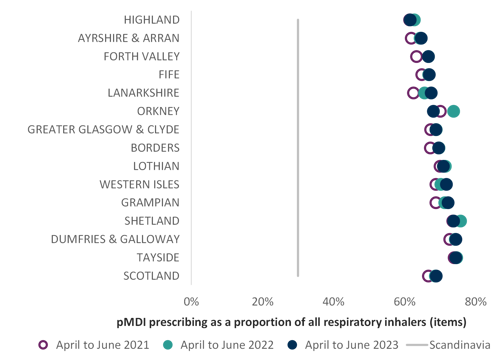Reduce carbon emissions from pMDIs
- The chart below shows the proportion of pMDIs dispensed as a proportion of all other inhalers (including dry powder inhalers and soft mist inhalers). As detailed above, the UK has a high proportion of pMDI use (70%) compared with the rest of Europe (< 50%) and Scandinavia (10–30%).75 The grey line on the chart indicates the Scandinavian level of pMDI prescribing at 30% as a comparator.
- There may be opportunities to discuss inhaler choices with patients at their regular respiratory review. Changes to inhaler type should only take place in discussion with the patient but may be an opportunity to reduce carbon emissions where disease control will not be compromised. An inhaler selection decision aid has been developed to support this guidance. It supports clinicians and patients when discussing the suitability of a DPI rather than an MDI.
- There are links to practical tips and support available from various sources to reduce carbon emissions from pMDIs, e.g. PrescQIPP and Greener practice.83,84 (see Resources for patients and clinicians).
Proportion of pMDIs versus all inhalers (dry powder and soft mist inhalers)

- The graph below highlights that the use of DPI for salbutamol is low.
- In NHS Scotland only 7.8% of salbutamol inhalers are DPIs.
- If consideration is given to switching a patient to a DPI the clinician should be confident that the patient can use the DPI for acute circumstances.
- They may not be suitable for the very young or very old (see the section on when DPI's may or may not be suitable)
Salbutamol DPI as a proportion of all salbutamol (items)

The numerical data for NTI graphs can also be viewed here.
The most up to date national therapeutic indicator data is available here.
